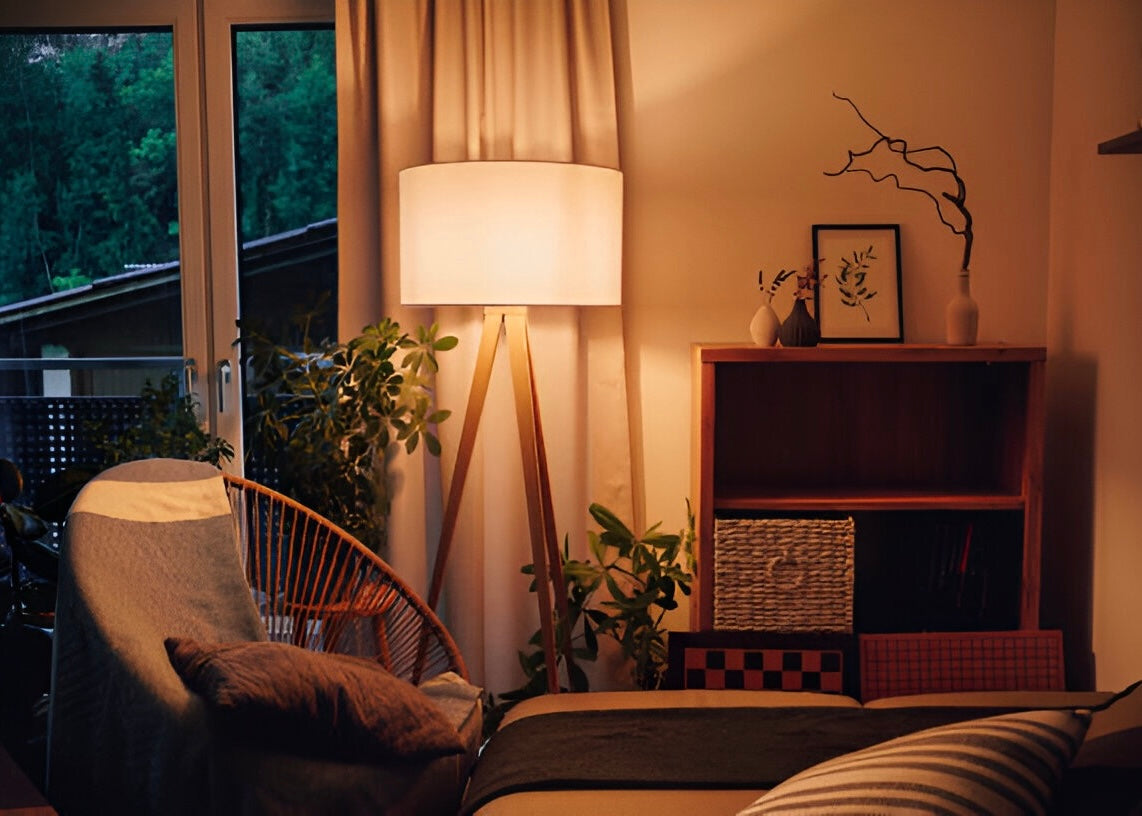
Lighting ideas small living room
Professional lighting planning for small living rooms: More brightness, space and coziness
Do you know the challenge: A compact living room often offers comfort, but it can also quickly seem dark, cramped and smaller than it actually is. Lighting in particular represents a central hurdle here. How do you create a lighting atmosphere that does not visually reduce the size of the room, but on the contrary conveys a feeling of space, brightness and, above all, comfort? A task that requires strategic thinking.
The good news is: with well-founded information Lighting ideas for your small living room significant improvements can be achieved. Light is much more than just a means of pure illumination; it is a powerful design element. It enables the creation of specific moods, the clear definition of living areas and also the optical enlargement of rooms. The sole, central ceiling light, which often casts harsh shadows and creates a flat effect, is rarely the ideal solution. In this article, we delve deep into the topic of smart lighting concepts that can transform your small living room into a bright, airy-looking and extremely cozy retreat.
I will introduce you to practical principles and concrete implementation suggestions on how you can fundamentally improve the feeling of space through targeted lighting planning. Prepare for in-depth insights that will help you put your small living room in its best light.
Structure of this article:
- The fundamental importance of light in small spaces
- The principle of light layers: A structured concept
- Additional tips for optimized lighting
- Your path to an individual lighting concept
- Avoid common mistakes in lighting planning
- Conclusion: Light as the key to a feeling of space and quality of living
The fundamental importance of light in small spaces
Before we go into the details of the implementation, let's briefly explain *why* light is so crucial, especially in a small living room. The answer lies in its effects:
- Perception of space: Inadequate or unfavorable lighting creates dark corners and makes rooms appear smaller and squatter. Bright, well-distributed lighting visually opens up the room.
- Atmosphere and well-being: The quality of light has a significant influence on how we feel in a room. A small living room should radiate coziness. Warm white, soft light is essential for this; cold, hard light often has a repellent effect.
- Supporting activities: Even in a limited space, different activities take place - reading, working, relaxing, social interaction. Each needs an appropriate level of lighting without making the room seem cluttered.
- Highlighting elements: Targeted lighting accents can highlight artwork, plants or architectural details, adding structure and visual interest to the room.
Effective lighting goes beyond just “making it bright”; it is an active part of the interior design.
Let's consider how these layers are constructed and how they can be used effectively in a small living room:
1. Basic lighting (ambient light): Create the basis
This level ensures general brightness for basic orientation in the room and avoids dark, unused corners. Especially in small rooms, this base should be gentle and even so as not to overwhelm.
- Ceiling lights: Flat lights or lights integrated into the ceiling (such as spots) are often more suitable than voluminous pendant lights that visually divide the room. A good strategy is to have multiple spots that direct light onto the walls (wallwashing), as this makes the room appear wider.
- Indirect light: This is a key element for small spaces. Light directed at and reflected from ceilings or walls creates a soft, diffused brightness. This makes the room appear taller and wider. Ceiling floodlights, wall lights or hidden LED strips behind furniture or curtains are ideal for this.
- Dimmability: A crucial feature. The ability to adjust the intensity of the basic lighting allows the atmosphere to be flexibly designed for different times of day and occasions - from bright lighting when necessary to muted mood lighting.
Well-founded tip: When it comes to basic lighting, prioritize soft, even distribution of light. Indirect sources are often more effective than direct light at promoting a sense of openness.

2. Task Light: Targeted functionality
This light level is used to specifically illuminate specific areas for activities such as reading, handicrafts or using a laptop. The focus here is on functionality, but space-saving solutions can also be found here.
- Floor lamps: Choose models with a slim design and a small footprint. A swivel or adjustable arm is very practical for positioning the light precisely. Placement behind the seating is ideal.
- Table lamps: They contribute significantly to comfort. In small rooms with limited storage space, narrower designs are ideal.
- Wall lights with swivel arm: A very space-saving and functional option. They provide directional light for activities without taking up valuable floor space.
Well-founded tip: Ensure there is sufficient brightness at your work or reading place, but avoid direct glare. The light source should ideally be positioned so that it does not shine at eye level.

3. Accent lighting: Create spatial depth
This layer is used to stage selected objects or areas to give the room character and visual depth. This is particularly important to give structure to small rooms and avoid a monotonous effect.
- Picture lights: Ideal for highlighting artwork or photographs. They draw the eye upwards and enliven the walls.
- Spotlights: Small, directional spotlights can highlight sculptures, special plants or decorative items on shelves. They can be mounted on the ceiling, wall or directly on furniture.
- LED strip: Extremely versatile, e.g. behind the TV (also reduces contrasts), along shelf edges or under sideboards. They create modern, indirect lighting effects and make furniture appear optically lighter ("floating").
- Wallwashers (uplights/downlights): Compact wall lights that emit light upwards and/or downwards create interesting light-dark patterns on the wall and emphasize the vertical dimension of the room.
Well-founded tip: Set accents consciously and carefully. Focusing on a few, carefully chosen highlights is more effective than trying to illuminate too many elements, which can make the room busy.

Additional tips for optimized lighting
The role of mirrors in lighting planning
A tried and tested but often underestimated trick: Place light sources so that their light is reflected by a mirror. This not only doubles the perceived brightness, but also creates an optical extension and additional depth through the reflection, which immediately makes a small room appear larger. A wall light next to a mirror or a table lamp in front of it are simple but effective examples.
Use of the vertical spatial dimension
By placing light sources at different heights and deliberately illuminating vertical elements (e.g. walls with wallwashing, tall plants with spots from below), you direct the viewer's gaze upwards. This emphasizes the height of the room and can significantly alleviate the feeling of confinement that can arise with a small footprint.
The effect of color temperature
Choosing the right color temperature of the light is crucial for an inviting and cozy living room. Warm white light (typically in the range of 2700-3000 Kelvin) creates a comfortable, relaxing atmosphere. Cold white light (over 4000 Kelvin), on the other hand, appears rather objective and cool and is often unsuitable for living spaces.
Choosing the right lampshades
Voluminous or dark, opaque lampshades absorb a lot of light and can appear visually bulky in small rooms. Instead, prefer shades made of light-colored, translucent materials such as thin fabric, glass or transparent plastics. These allow the light to diffuse better and appear lighter in the room.
Efficient placement of floor lamps
To avoid tripping hazards and unnecessarily clutter up the room, place floor lamps in corners of the room or behind larger pieces of furniture such as sofas or armchairs. This way you make optimal use of the available space and the light fulfills its function without being dominant in the room.
Intelligent selection instead of mass
Although a layered lighting concept requires multiple light sources, this does not mean overcrowding the room with lights. The art lies in intelligent selection and strategic placement. Choose lights that may fulfill multiple functions or can be integrated unobtrusively. Careful planning of which light serves which purpose is helpful here.

Your path to an individual lighting concept
Developing a suitable lighting concept may seem complex at first, but it can be implemented in a structured manner:
- Inventory: Analyze your room in natural light and in the evening. Where are there deficits? Which areas are used for specific purposes? Where are the spaces particularly tight?
- Conception of basic lighting: Define how you want to ensure a comfortable basic brightness. Consider whether indirect light or a diffuse ceiling light is the best solution. Plan where dimming functions would be useful.
- Planning zone lighting: Identify the areas that need special light (reading area, work surface). Choose suitable task lights and determine their optimal, space-saving positions.
- Integration of accents: Think about which objects or areas you want to highlight. Plan where targeted accent lights such as spotlights or wallwashers can highlight them.
- Strategic use of mirrors: Consider how you can use mirrors to reflect light and enhance the sense of space.
- Selection of lights and implementation: Choose lights that fit functionally and stylistically and whose size is appropriate for the room. Place these according to your planning.
- Fine tuning: Test the different lighting scenarios. Switch on individual lights and combinations and use the dimming functions. Make adjustments as needed until the room feels optimally lit.
Avoid common lighting mistakes
- Relying on a single light source: This leads to uneven, often shadowy illumination.
- Choose unsuitable bulbs: In particular, a color temperature that is too high (cold white) or light intensity that is too low (lumens) impairs the atmosphere and functionality.
- Ignore the vertical dimension: Only horizontal lighting makes the room appear flat.
- Use lights that are too large: These can seem overwhelming in small rooms.
- Do not use lighting as a design element: Consider light exclusively functionally, instead of consciously using it to improve the feeling of space.
Important note about installation: Ideally, you should plan the electrical connections (wall connections, sockets) to match your lighting concept. However, many solutions can also be implemented with cleverly laid cables and adapters.
Conclusion: Light as the key to a feeling of space and quality of living
Lighting a small living room is a design task that can be mastered excellently with the right knowledge. It's less about increasing the number of square meters and more about creating a feeling of openness, brightness and, above all, a high level of comfort through well-thought-out lighting. The principles of light layers presented here (basic, work and accent light), the strategic use of indirect light and mirrors as well as the conscious choice of luminaire types and color temperature form the basis for a successful lighting concept.
Take the time to examine the different approaches and adapt them for yourself. Find the combination that best suits your individual living style and needs. You will notice what a significant, positive difference a well thought-out lighting concept makes. This will not only make your small living room appear brighter, but noticeably more inviting, more lively and simply more livable. It is your personal retreat, the quality of which is significantly increased by the right light.
I hope this article has given you valuable, informed insight and inspiration for lighting your small living room! Good luck with the implementation and enjoy your optimally lit home!
Internal sources:
- Lighting Trends 2025: Eco-Conscious, Smart, and Replaceable
-
Light planning and optimal lighting in the living room: A comprehensive guide
External sources:


